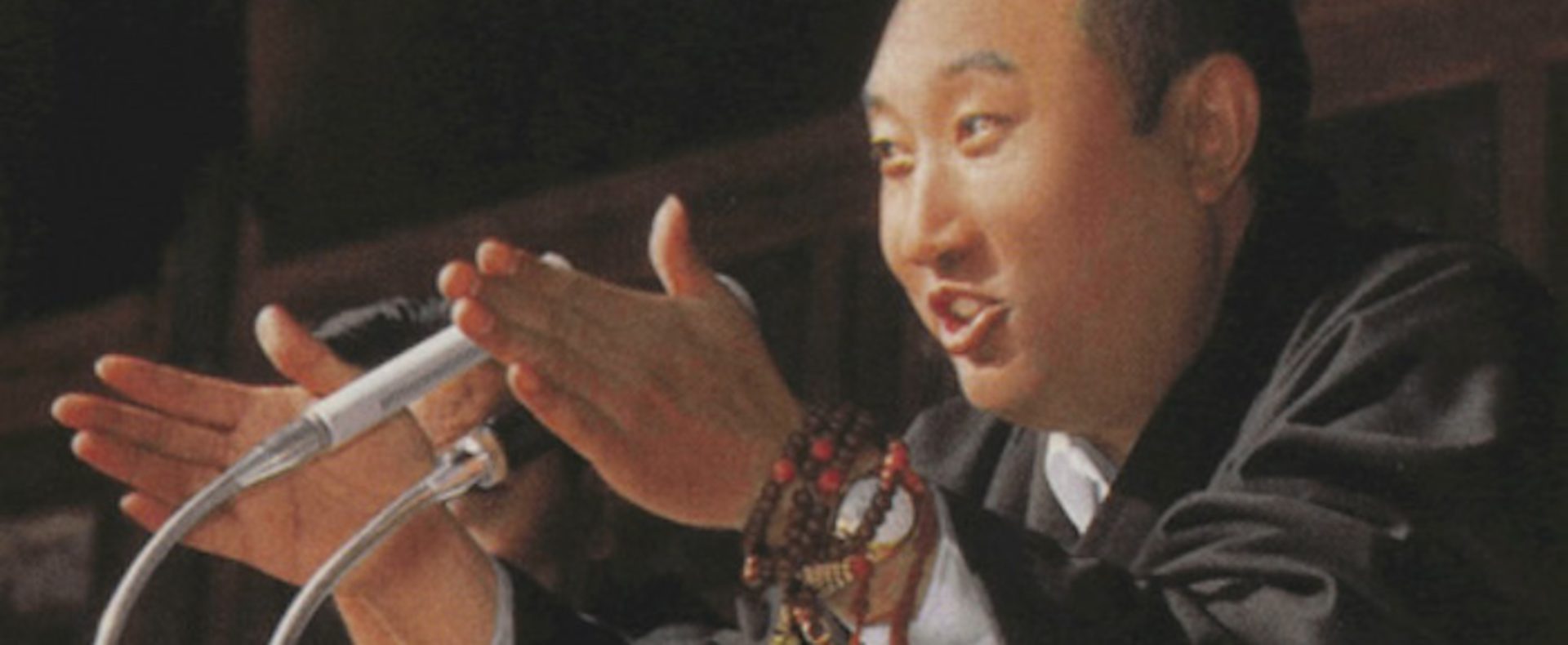
Born: 1938, Amdo, Eastern Tibet | Died: 1989, Xigazê, Tibet Autonomous Region, China
Name in Chinese: 确吉坚赞 (quèjí jiānzàn)
Also known as: Panchen Erdeni (班禅额尔德尼; bānchán éěrdéní) (religious title); Gönbo Cêdän (birth name)
Roles:
Choekyi Gyaltsen was the 10th title holder in the succession of the Panchen Lamas, the third highest ranking figure after the Dalai Lama and the Karmapa lama in the hierarchy of Tibetan Buddhism.
His predecessor, the 9th Panchen Lama Thubten Choekyi Nyima, fled Tibet in 1923 because of his loyalty to the Republic of China, and was effectively used by the Nationalist Kuomintang government to weaken the Tibetan’s efforts to prove their independence as a unitary state. Upon the 9th Panchen Lama’s death in 1937, the search for his reincarnation produced two competing candidates. The regency Lhasa government, preceding the enthronement the 14th Dalai Lama, supported one candidate born in 1938. The Kuomintang’s Mongolian and Tibetan Affairs Commission put forward their own candidate from Eastern Tibet, and in 1949 enthroned him as Choekyi Gyaltsen. The Dalai Lama’s regency government refused to recognize him.
At first the Kuomintang wanted to use their 10th Panchen Lama as an anti-communist leader but in 1950 they lost the civil war. The Chinese Communist Party (CCP) co-opted the Panchen Lama, who declared his supported their claim of sovereignty over Tibet, and lent the appearance of legitimacy to their invasion. For reasons best known only to the 14th Dalai Lama, in 1952 he formally accepted Choekyi Gyaltsen as the official 10th Panchen Lama. The Lhasa government’s original choice (the de-facto 10th Panchen Lama) was conferred a new title, Panchen Ötrul (‘Panchen Candidate’) who outlived Choekyi Gyaltsen and emigrated to Ireland.
After 1959, Choekyi Gyaltsen set great faith in the CCP's promises of Tibetan autonomy. However, this faith did not prevent his vilification in the 1960s during the Cultural Revolution, after he began to criticise the brutal suppression of Tibetans by the Chinese. In 1964 he was imprisoned. When freed in 1977, he was given the outward trappings of respect but not allowed to live in Tibet. He took a Han Chinese wife Li Jie, daughter of a PLA general, who bore a daughter named Yabshi Pan Rinzinwangmo who became the first sanctified communist woman. In 1982 Choekyi Gyaltsen was politically rehabilitated and rose to prominent positions in the National People’s Congress and the state-operated Buddhist Association of China (BAC).
During the 1980s, the Chinese authorities did not really fear “separatism” spreading from Tibetan monasteries, as they had been mostly destroyed. They worked to gain the confidence of high-ranking clerics as a means of promoting patriotism among Tibetans. The Panchen Lama played the game, generating financial support for Chinese efforts to rebuild certain religious sites. Choekyi Gyaltsen incepted the Tibet Development Fund (TDF), a “GONGO” (Government-Organised Non Governmental Organisation) under the direction of the the CCP’s United Front Work Department (UFWD) established to finance the “self-sufficient” socialist New Tibet and fill Chinese coffers in the region. In 1984 he recruited the “patriotic overseas Tibetan” Akong Tulku to this cause.
In 1987 he was appointed Dean of the China Advanced Institute of Tibetan Buddhism, founded that year by BAC president Zhao Puchu with State Council approval, to cultivate and build a reserve of Tibetan Buddhists who are “politically reliable, educated and venerable.”
In 1989 Choekyi Gyaltsen returned to Tibet to re-inter the bones of the previous Panchen Lamas, recovered from graves destroyed in the Cultural Revolution. In a speech he said: “Since liberation, there has certainly been development, but the price paid for this development has been greater than the gains.” Five days later, he collapsed and died. The official cause of death was a heart attack, but rumours of poisoning spread. Although he was not in good health, foul play was suspected, particularly as within the space of a few days his mother, father, and senior tutor also died of heart attacks. Hu Jintao, then TAR Party Secretary, had accompanied Choekyi Gyaltsen on this final trip. In 2011, the Chinese dissident Yuan Hongbing declared that Hu Jintao had engineered the Panchen Lama’s death, stating “Hu Jintao rose to the top position of CCP regime by stepping on the blood, bones and tears of the Tibetan people.”
To truly understand the 10th Panchen Lama’s role in China’s control over Tibet, there is a certain logic to follow. Most think of confrontations in terms of wars or sports contests. As such, the Panchen Lama’s role could be compared to a tennis player, prompting questions “for whom does he play?” or “who won the game?” But for the Chinese, the players and the contest are not so important – they care most about the ground, and they own the tennis court. Few ask who owns Flushing Meadows because most don’t care. The 10th Panchen Lama was a player who legitimised the Chinese ownership of Tibetan territory. To the Chinese, it did not matter whom he fought against, or whether he won or lost, as long as he never challenged the Chinese ownership of Tibet.